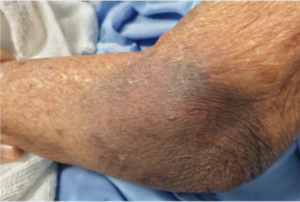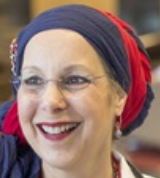
‘Those nasty looking purple “bruises” on your elderly mother’s or grandfather’s arms are not as harmful as they look.
But they can easily resemble marks from elder abuse.
Don’t be alarmed if these purple marks begin showing up on their skin; it’s common among the very elderly.
Bruising from physical abuse will eventually turn green, whereas these particular purple bruises stay purplish.
The purple bruises that are common on a very elderly person’s arms will not cause any problems to that individual other than a cosmetic concern.
However, they are the result of a problem.
“As we age, we lose the underlying connective tissue ‘cushion’ that protects us,” says Susan L. Besser, MD, with Mercy Medical Center, Baltimore, and Diplomate American Board of Obesity Medicine and board certified by the American Board of Family Medicine.
“That is why elderly tend to have frail skin,” continues Dr. Besser.
“Since there is less cushion, the superficial blood vessels are closer to the surface of the skin (and are also more fragile), so they break more easily.
“That is what causes the bruising: leakage of blood into the skin and tissues beneath the skin.”
Is there a way to prevent developing these pitiful looking purple bruises as you go deeper and deeper into old age?
Well, have you noticed that the elderly people who have these in the most pronounced way also tend to be quite thin and appear to have very little muscle mass?
Though loss of muscle mass with age is a natural occurrence, there is also the issue of suppressed appetite in the elderly.
In fact, malnourishment is a huge problem among very elderly people.
If the muscle has wasted away due to a combination of lifelong avoidance of strength training and proper nourishment, there just won’t be much tissue between those aged blood vessels and the skin.
If you don’t lift weights, then START. You’ll build lean muscle that will boost resting metabolic rate.
Weight-bearing exercise, along with eating an adequate amount of healthy food, will go a long way in preventing that tissue-paper-thin look that’s so common in the elderly’s skin.
 Dr. Besser provides comprehensive family care, treating common and acute primary conditions like diabetes and hypertension. Her ongoing approach allows her the opportunity to provide accurate and critical diagnoses of more complex conditions and disorders.
Dr. Besser provides comprehensive family care, treating common and acute primary conditions like diabetes and hypertension. Her ongoing approach allows her the opportunity to provide accurate and critical diagnoses of more complex conditions and disorders.
 Lorra Garrick is a former personal trainer certified through the American Council on Exercise. At Bally Total Fitness she trained women and men of all ages for fat loss, muscle building, fitness and improved health.
Lorra Garrick is a former personal trainer certified through the American Council on Exercise. At Bally Total Fitness she trained women and men of all ages for fat loss, muscle building, fitness and improved health.
.
























